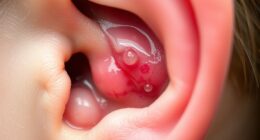Entering the realm of therapy techniques for Central Auditory Processing Disorder is like maneuvering through a complex maze of auditory obstacles that require creative solutions.
As we explore the landscape of strategies designed to enhance auditory processing skills, a myriad of effective approaches beckon. From auditory discrimination training to music-based interventions, each technique holds the promise of unraveling the mysteries surrounding CAPD.
Join us on this journey as we unravel the transformative potential of these ten therapy techniques, shedding light on the path towards improved auditory processing abilities.
Key Takeaways
- Auditory Discrimination Training and Environmental Sound Therapy improve auditory processing skills.
- Cognitive strategies enhance self-awareness and problem-solving for CAPD.
- Speech-in-Noise Training and Auditory Memory Exercises aid in speech comprehension.
- Cognitive Behavioral Therapy and Assistive Listening Devices offer structured support for CAPD management.
Auditory Discrimination Training
Auditory discrimination training is a crucial therapeutic approach focusing on enhancing the ability to differentiate between similar auditory stimuli, specifically designed to address specific deficits in individuals with Central Auditory Processing Disorder (CAPD). This therapy targets auditory processing deficits by engaging individuals in activities that require them to identify differences in pitch, tone, or speech sounds.
By honing auditory discrimination skills, individuals can better comprehend and process auditory information, leading to improved communication and listening abilities.
In the realm of CAPD therapy, auditory discrimination training plays a vital role in helping individuals overcome challenges in distinguishing subtle variations in auditory stimuli. Through targeted exercises and interventions, this therapy aims to sharpen the individual's capacity to discern between sounds that may have previously appeared indistinguishable.
Environmental Sound Therapy

We'll explore the benefits of sound therapy for individuals with Central Auditory Processing Disorder (CAPD), the essential setup for therapy sessions, and how progress is monitored throughout treatment.
By understanding these key points, therapists can tailor environmental sound interventions to meet the specific needs of each individual with CAPD.
This approach ensures that therapy is effective in optimizing auditory processing and improving overall communication abilities.
Sound Therapy Benefits
In optimizing auditory processing for individuals with Central Auditory Processing Disorder (CAPD), environmental sound therapy focuses on modifying the listening environment to enhance speech understanding and reduce auditory processing challenges.
Environmental sound therapy aims to create a more favorable auditory setting by improving acoustics, reducing background noise, and enhancing the signal-to-noise ratio. This therapy involves utilizing sound-absorbing materials, optimizing room layout, and incorporating assistive listening devices.
Therapy Session Setup
When setting up therapy sessions for environmental sound therapy, the focus is on creating a controlled auditory environment to enhance auditory processing skills. This involves reducing background noise and distractions to optimize the individual's ability to process speech effectively. Utilizing specialized equipment such as noise-canceling headphones or sound machines can further enhance the auditory experience. The goal is to strengthen central auditory processing abilities by tailoring the therapy to address the specific needs and challenges of each individual. By providing a clear and focused auditory environment, environmental sound therapy aims to maximize therapeutic benefits for individuals with central auditory processing disorder.
| Auditory Environment | Specialized Equipment | Therapeutic Benefits |
|---|---|---|
| Reduce background noise | Noise-canceling headphones | Enhance auditory skills |
| Minimize distractions | Sound machines | Strengthen processing |
| Focus on speech clarity | Maximize therapeutic gains |
Monitoring Progress
Monitoring progress in environmental sound therapy involves systematically tracking changes in auditory discrimination, sound localization, and speech comprehension to evaluate the effectiveness of the intervention and tailor treatment strategies accordingly.
- Auditory Discrimination: Assessing the individual's ability to differentiate between similar sounds helps gauge improvements in auditory processing skills.
- Sound Localization: Monitoring advancements in pinpointing the origin of sounds aids in enhancing spatial hearing capabilities.
- Speech Comprehension: Evaluating the individual's understanding of spoken language assists in determining the therapy's impact on communication skills.
- Therapy Effectiveness: Regularly reviewing progress in environmental sound therapy enables therapists to adapt interventions for optimal outcomes based on the individual's response to the treatment.
Speech-in-Noise Training

Speech-in-noise training includes noise filtering exercises, auditory discrimination tasks, and communication in noise activities. These techniques are designed to improve speech perception and understanding in challenging listening environments for individuals with Central Auditory Processing Disorder (CAPD).
Noise Filtering Exercises
Noise filtering exercises, also known as speech-in-noise training, aim to enhance individuals' ability to comprehend speech in challenging auditory environments by practicing listening to speech amidst background noise.
When delving into noise filtering exercises, consider the following:
- Enhancing Auditory Discrimination: These exercises improve the ability to differentiate speech sounds from background noise.
- Developing Speech Perception Skills: Individuals learn to focus on important speech cues while filtering out irrelevant sounds.
- Adapting to Noisy Environments: Training helps individuals with Central Auditory Processing Disorder (CAPD) adapt to and function better in noisy settings.
- Improving Speech Comprehension: The ultimate goal is to enhance speech perception and comprehension in adverse acoustic conditions, aiding those with CAPD.
Auditory Discrimination Tasks
Auditory discrimination tasks, crucial for individuals with Central Auditory Processing Disorder (CAPD), involve honing the ability to distinguish speech sounds amidst varying levels of background noise to improve comprehension in challenging auditory environments.
Speech-in-noise training is a key component of these tasks, aiming to enhance auditory processing skills, including sound recognition and discrimination, in difficult listening conditions. By practicing differentiating speech sounds in the presence of background noise, individuals with CAPD can boost their understanding and processing of spoken language.
Engaging in speech-in-noise training can lead to improved communication outcomes and enhanced listening skills for individuals with CAPD, ultimately helping them navigate noisy environments more effectively. These targeted exercises play a vital role in addressing the specific needs of individuals with Central Auditory Processing Disorder.
Communication in Noise
Utilizing targeted practice sessions, individuals with Central Auditory Processing Disorder focus on enhancing their ability to understand speech amidst challenging background conditions through communication in noise training.
- Speech-in-noise training emphasizes improving speech comprehension in noisy environments for individuals with CAPD.
- Participants engage in listening to speech stimuli amidst varying levels of background noise to refine their auditory processing skills.
- Evidence supports significant enhancements in speech perception and comprehension following speech-in-noise training.
- Structured sessions enable gradual adaptation to challenging listening conditions, aiding individuals in developing strategies for better speech-in-noise perception.
Incorporating speech-in-noise training into a comprehensive therapy plan can effectively address the unique struggles individuals face in understanding speech in noisy settings.
Auditory Memory Exercises

Engaging in structured auditory memory exercises can significantly enhance the retention and recall of auditory information for individuals with Central Auditory Processing Disorder (CAPD). These exercises are tailored to improve short-term memory for auditory stimuli, such as sequences of sounds or spoken instructions, which are common challenges for individuals with Auditory Processing Disorders.
By participating in auditory memory training, individuals can enhance their auditory processing skills, leading to improved language comprehension, speech, and overall communication abilities. Tasks involved in auditory memory exercises may include repeating back spoken sentences, recalling lists of words, or identifying patterns in auditory information.
Consistent practice of these exercises is crucial as it can result in enhanced listening comprehension and better retention of auditory details during everyday interactions. Through targeted auditory memory training, individuals with CAPD can strengthen their skills, ultimately facilitating more effective communication and interaction in various settings.
Metacognitive Strategies

Metacognitive strategies play a crucial role in therapy for Central Auditory Processing Disorder by enhancing individuals' ability to monitor and regulate their cognitive processes during auditory tasks.
These techniques focus on fostering self-awareness regarding how auditory information is processed and improving listening skills.
Through the application of metacognitive skills, individuals with CAPD can effectively manage their auditory processing difficulties and enhance their overall learning experience.
Cognitive Reflection Techniques
Through active reflection on one's thinking processes, individuals with Central Auditory Processing Disorder (CAPD) can enhance their auditory processing skills using cognitive reflection techniques. These metacognitive strategies enable individuals to monitor, assess, and adjust their listening and comprehension strategies, promoting self-awareness and self-regulation in auditory tasks. By encouraging reflection on listening behaviors and adapting approaches, individuals can improve communication and learning outcomes. Implementing cognitive reflection techniques in therapy empowers those with CAPD to become more effective listeners in diverse environments.
- Monitoring and assessing listening strategies.
- Promoting self-awareness and self-regulation in auditory tasks.
- Adapting listening behaviors for improved communication.
- Enhancing learning outcomes through cognitive reflection techniques.
Problem-Solving Awareness Exercises
How can problem-solving awareness exercises benefit individuals with Central Auditory Processing Disorder (CAPD) in developing a deeper understanding of their auditory processing challenges?
Problem-solving awareness exercises, a metacognitive strategy, assist individuals in recognizing and addressing their auditory processing difficulties. These exercises involve identifying specific problems related to auditory processing, like struggling to comprehend speech in noisy settings.
By engaging in these exercises, individuals with CAPD can create personalized strategies to overcome challenges and enhance their auditory processing skills. Through the use of metacognitive strategies such as problem-solving awareness exercises, individuals with CAPD can improve self-monitoring and self-regulation of their auditory processing difficulties.
Incorporating these exercises into therapy sessions can empower individuals to actively manage and address their auditory processing issues.
Direct Instruction Techniques

Direct instruction techniques in therapy for Central Auditory Processing Disorder (CAPD) utilize structured, explicit teaching methods to target specific auditory processing skills. These techniques provide a systematic approach to improving auditory processing abilities in individuals with CAPD.
Here are four key aspects of direct instruction techniques:
- Focused Skill Development: Direct instruction techniques concentrate on enhancing sound discrimination and auditory memory, essential components of effective auditory processing.
- Language Processing Strategies: Therapists use direct instruction to teach practical strategies for improving language processing and comprehension, aiding individuals in better understanding auditory information.
- Active Listening Enhancement: By incorporating direct instruction methods, individuals with CAPD can develop active listening skills, improving their ability to engage with and process auditory stimuli effectively.
- Clear Guidance: Direct instruction techniques offer individuals with CAPD clear, step-by-step guidance, supporting them in building foundational auditory processing skills necessary for daily communication and learning tasks.
Visual Support Integration

Visual support integration enhances the comprehension and retention of auditory information for individuals with Central Auditory Processing Disorder (CAPD) by incorporating visual aids like pictures, diagrams, and written instructions. Visual aids provide additional cues and context to help individuals with CAPD better understand verbal instructions, navigate complex auditory environments, and improve communication outcomes. By integrating visual support into therapy sessions and daily activities, individuals with CAPD can experience enhanced auditory processing and communication skills. The table below outlines the key benefits of visual support integration in CAPD therapy:
| Visual Support Integration Benefits | |
|---|---|
| Enhances Comprehension | Provides additional cues for understanding auditory information |
| Improves Retention | Helps individuals retain spoken instructions more effectively |
| Facilitates Communication | Aids in navigating complex auditory environments |
| Enhances Therapy Effectiveness | Improves overall communication outcomes in individuals with CAPD |
Music-based Interventions

Music-based interventions play a crucial role in enhancing auditory processing skills for individuals with Central Auditory Processing Disorder (CAPD). These interventions serve as a therapeutic tool to address auditory processing deficits and improve overall communication abilities.
Here are four key aspects of music-based interventions for CAPD:
- Auditory Discrimination: Through music therapy, individuals can improve their ability to differentiate between sounds and enhance their auditory discrimination skills, which are often impaired in CAPD.
- Temporal Processing: Rhythmic exercises incorporated in music interventions help individuals with CAPD to better process and organize auditory information in time, improving temporal processing abilities.
- Neural Connections: Music elements such as melody and harmony can be structured to target specific deficits, facilitating the development of neural connections in the auditory processing areas of the brain.
- Auditory Memory Tasks: Engaging in melodic contour identification and auditory memory tasks within music therapy sessions helps strengthen auditory memory, a vital component of processing auditory information effectively.
Cognitive Behavioral Therapy

Exploring new therapeutic avenues for individuals with Central Auditory Processing Disorder (CAPD), Cognitive Behavioral Therapy (CBT) offers a structured and goal-oriented approach to identifying and modifying negative cognitive patterns and behaviors associated with auditory processing challenges.
In the context of CAPD, CBT serves as a valuable tool in helping individuals manage stress, anxiety, and frustration stemming from difficulties in auditory processing. By enhancing coping skills, improving self-awareness, and fostering adaptive behaviors, CBT equips individuals with CAPD to navigate communication hurdles effectively.
Tailored CBT techniques can address specific issues related to auditory processing, such as attention, memory, and processing speed, through targeted interventions and strategies. Research indicates that integrating CBT into the treatment plan for individuals with CAPD can lead to improved emotional well-being, increased self-efficacy, and an overall enhancement in quality of life.
The structured nature of CBT makes it a promising avenue for individuals looking to develop resilience and overcome the challenges posed by auditory processing difficulties.
Assistive Listening Devices

Assistive listening devices, including FM systems and personal amplifiers, play a crucial role in enhancing sound clarity and reducing background noise for individuals diagnosed with Central Auditory Processing Disorder (CAPD). These devices are essential tools in providing auditory support and improving speech understanding for individuals with CAPD.
Here are four key points to consider:
- Improved Sound Clarity: Assistive listening devices capture and enhance sound, delivering it directly to the individual's ear. This process helps individuals with CAPD better distinguish speech from background noise, leading to improved sound clarity.
- Reduced Background Noise: By bypassing environmental distractions, FM systems and personal amplifiers reduce background noise, allowing individuals with CAPD to focus more effectively on the auditory information they need to process.
- Enhanced Speech Understanding: FM systems, commonly used in educational settings, consist of a transmitter microphone and a receiver that work together to enhance speech understanding, particularly in noisy environments.
- Personalized Auditory Support: Personal amplifiers are portable devices that amplify sounds from specific sources, such as conversations or electronic devices, offering personalized auditory support tailored to the individual's needs.
Frequently Asked Questions
How to Help Someone With Central Auditory Processing Disorder?
To help someone with central auditory processing disorder, we recommend implementing the following interventions:
- Environmental modifications
- Speech-language therapy
- Encouraging the use of compensatory strategies
These interventions can improve sound discrimination, memory, language skills, and communication effectiveness for individuals with CAPD. By creating personalized strategies, routines, and engaging in audiologic training, individuals can enhance their auditory processing skills and overall quality of life.
What Are the Intervention Strategies for Central Auditory Processing Disorder?
Intervention strategies for Central Auditory Processing Disorder (CAPD) focus on compensatory approaches, such as active listening techniques and speech therapy to enhance reading and language comprehension. Children with CAPD benefit from sound discrimination training, auditory memory exercises, and language-processing strategies tailored to match the disorder's type and intensity.
Lifestyle changes like improving classroom acoustics and using auditory attention games can further support individuals with CAPD.
What Tools Help Auditory Processing Disorder?
We find that tools like computer-assisted training programs, visual aids, and assistive listening devices can significantly aid individuals with auditory processing disorder. These tools can improve auditory discrimination skills, help follow instructions better, enhance sound clarity, and reduce background noise interference.
Additionally, speech therapy techniques focusing on reading comprehension and language processing, along with educational tools like language-processing strategies and memory exercises, can further develop stronger auditory processing abilities.
What Are Coping Strategies for Apd?
When facing APD, we rely on coping strategies to navigate challenges. Requesting clarification and repetition, leveraging recording devices, and developing personalized tactics aid in communication. These measures empower us to manage daily tasks effectively.
Are Auditory Sensitivity Activities also Effective for Central Auditory Processing Disorder Therapy?
Yes, occupational therapy auditory sensitivity activities can be effective for central auditory processing disorder therapy. These activities help individuals with sensory processing issues by gradually exposing them to different sounds and helping them manage their auditory sensitivities. This can significantly improve their auditory processing skills over time.
Conclusion
In conclusion, incorporating a combination of auditory discrimination training, speech-in-noise therapy, and auditory memory exercises can significantly improve outcomes for individuals with Central Auditory Processing Disorder.
By utilizing metacognitive strategies, visual support integration, and music-based interventions, we can enhance overall auditory processing abilities.
Cognitive behavioral therapy and assistive listening devices further contribute to a comprehensive treatment approach.
Together, these techniques create a harmonious symphony of strategies to help individuals navigate the complexities of CAPD with precision and effectiveness.











